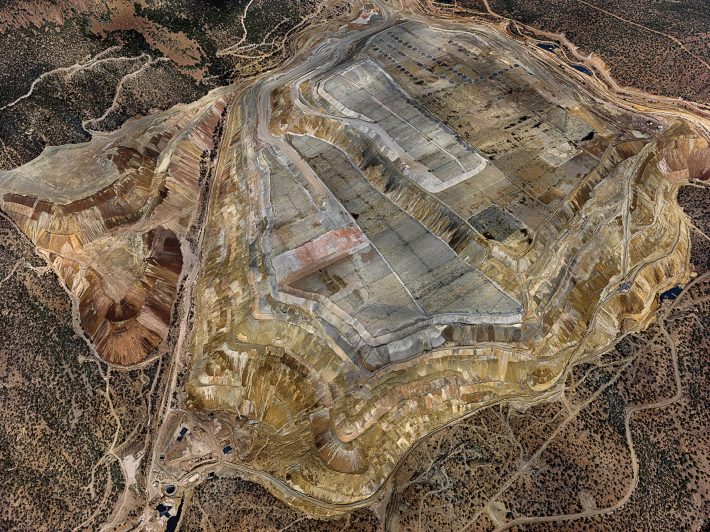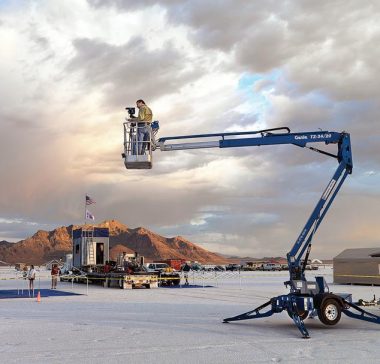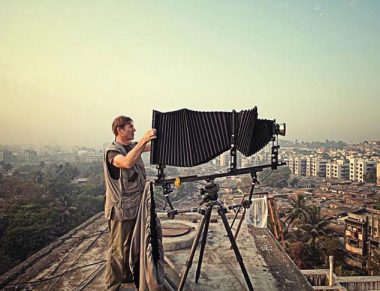by Stephen Wallis, via wsj.com

ABOVE AND BEYOND | Edward Burtynsky’s Chino Mine #1 (2012), taken in Silver City, New Mexico, on view this fall at New York’s Howard Greenberg Gallery Photo: © Edward Burtynsky, courtesy of Nicholas Metivier Gallery, Toronto/Howard Greenberg Gallery, and Bryce Wolkowitz Gallery, New York
STARTING IN THE 1990S, advances in digital technology made it easier for photographers to print their work at previously unimaginable sizes. The result was a golden age of vast pictures—typified by the work of artists such as Andreas Gursky—with the kind of impact previously limited to painting or films. But in these social-media–saturated times, when we’re constantly thumbing through palm-size images shared freely on Instagram, Twitter and Facebook, is there still a meaningful place for photographs measured in feet?
For Edward Burtynsky and Robert Polidori, two of today’s most esteemed practitioners of large-scale photography, the answer is unequivocally yes. And this fall they are both offering fresh reminders of their art’s visual power and relevance with gallery shows and new books. Both Canadian-born, these two artists have spent the past three decades working on loosely parallel tracks, each bringing a sharp aesthetic eye to documentary images that thoughtfully address issues of historical, socioeconomic and ecological consequence. Technically ambitious and often shot in far-flung, challenging locales, their photographs provide perspectives rarely seen. Seductive yet unnerving, they act like mirrors, revealing things about who we are and what we’re becoming.
In a way, Edward Burtynsky’s artistic path is the result of a wrong turn. Driving through Pennsylvania in the early ’80s, he wound up in the tiny coal-mining town of Frackville, where he suddenly found himself in a surreal landscape stripped of all traces of nature. He knew then that he’d discovered his mission. “We’re an expanding population that’s bearing down on the resources of the planet,” says the photographer, who has since traversed the globe shooting mines and quarries, oil fields and factories, waterways and farmlands. His bird’s-eye views, often captured from planes, helicopters and, more recently, drones, take an unsparing look at the relationship between humans and nature.

Edward Burtynsky, shooting from a crane, at Bonneville Salt Flats, Utah. Photo: Joseph Hartman
Today, Burtynsky oversees a busy Toronto studio, where a small team coordinates logistics for his complex shoots, performs postproduction work and communicates with museums and his 11 galleries around the world. His first new body of work in four years, a group of photographs of Indian salt farms, is being unveiled this fall by galleries in three cities: Flowers in London (through October 29), Nicholas Metivier in Toronto (September 29–October 22) and both Howard Greenberg (November 4–December 31) and Bryce Wolkowitz (November 3–December 23) in New York. Also on display will be a selection of photographs from the forthcoming book Essential Elements (Thames & Hudson), a survey of Burtynsky’s career that pairs familiar images with pictures from his lesser-known series.
To capture the salt works, Burtynsky traveled to the Indian state of Gujarat, to an area near the Arabian Sea known as the Little Rann of Kutch. Here more than 100,000 laborers work in a 400-year-old salt-harvesting industry now under threat from a receding water table and unfavorable market forces. Using his 60-megapixel Hasselblad camera, Burtynsky shot from both a helicopter and a Cessna at altitudes between 300 and 4,000 feet. The resulting images (Steidl is publishing a book of them this month) are captivating studies in pattern and color variations. While the salt pans differ in size, shape and configuration, the palette ranges from gray, brown and white to ochre, pink and pale blues and greens.
Getting up close to a Burtynsky photograph, the largest of which measure nearly five by seven feet, is a visceral encounter. Unable to take in the entire picture at once, your eyes scan the surface as the image almost envelops you. “At that scale, there’s this hovering-over, bodily experience that I like to work with,” says Burtynsky. “You stand in front of it, and there’s an almost dizzying, vertigo-like effect.”
That many of his landscape images, from Spanish dryland farms to New Mexico copper mines to Chinese rice terraces, evoke abstract painting isn’t lost on Burtynsky or his dealers. “He has been coming back to a more abstract visual idea,” says Howard Greenberg, who has co-represented Burtynsky in New York with Bryce Wolkowitz for the past several years. “He’s done that by shooting from even greater heights and eliminating the horizon.”

LOOK SHARP | Robert Polidori’s Hotel Petra #7 (2010), shot in an abandoned Beirut hotel, part of a show at New York’s Paul Kasmin Gallery. Photo: Courtesy of Robert Polidori and Paul Kasmin Gallery (2)
An important element of Burtynsky’s career has been his eagerness to embrace new mediums and technologies, whether employing drones or experimenting with photogrammetry, a process that uses software to translate two-dimensional images of an object, taken from multiple angles, into a rendering that appears 3-D when viewed with virtual-reality goggles. Currently, Burtynsky’s team is working with some 2,300 images he shot before an ivory burn—the destruction of illegally obtained elephant tusks, meant to curb poaching—in Kenya earlier this year. “The technology isn’t quite there yet,” the photographer says, “but the idea is to have this pile of tusks, which was 20 feet high and 20 feet across, rendered in a way that would allow you to put on a VR headset and experience it at scale by walking around it.” Burtynsky’s aim with all of his work is “to have the viewer spend time with and really consider these worlds,” he says. “I want people to enter them.”
Describing his approach as a photographer, Robert Polidori says he is “basically an impressionist.” The Montreal native, who recently moved his studio to Ojai, California, after three years in Los Angeles, clarifies that by adding, “I’m a medium, not a creator.” Despite his journalistic impulse—he has shot for many publications and was a staff photographer for The New Yorker from 1998 to 2006—Polidori has never been purely a documentarian. His interest has always lain in making “psychological portraits” of architectural spaces, which he sees as vessels for memories and as projections of the people who have lived there.
The photographer’s best-known series include shots of the Château de Versailles under restoration, crumbling old Havana interiors, New Orleans homes devastated by Hurricane Katrina and deserted sites near the Chernobyl nuclear disaster. “I picked Chernobyl as a subject because I thought it was historically important, a signal,” the photographer says. “It was a modern-day Pompeii, but it was an event caused not by nature but by man’s irresponsibility.”
This fall Polidori is having his first show with the Paul Kasmin Gallery in New York. On view through October 15 are several of the evocative photographs Polidori shot inside Beirut’s deserted and crumbling Hotel Petra as well as three monumental works related to his interest in urban slums and favelas, places he refers to as “auto-constructed cities—the sort of wild, self-made, non-sanctioned settlements that come out of an organic need.” Created from pictures he took in Mumbai, India, these technically remarkable works were a decade in the making.

Robert Polidori using his view camera. Photo: Courtesy of Robert Polidori and Paul Kasmin Gallery
Polidori’s Hotel Petra photographs—the subject of a book Steidl is publishing in December—are reminders of the lasting impact of Lebanon’s long civil war. The once-grand building was badly damaged in that conflict, which lasted from 1975 to 1990, and was left abandoned for many years before eventually being demolished. Polidori’s images, some of which stand six feet high, are ravishing meditations on the concepts of transience and decay, the cracked and peeling walls revealing layers of history.
“His commentary on humans’ relationship with architecture and on the changing world is incredibly compelling,” says Paul Kasmin. “Plus, his working process is quite extraordinary.”
Polidori shoots with a massive view camera with giant bellows, using large-format film, up to 11 by 14 inches, because, he explains, “I love the smoothness and higher resolution of film. Also, I like having something physical that the image is embedded in.” Everything is later scanned into digital form, allowing him to create works such as the centerpiece of his show at Kasmin: a panorama of 60 Feet Road, a street of makeshift dwellings in Mumbai’s Dharavi slum. Polidori started by photographing one side of the road’s entire length, moving his camera laterally, tracking-shot style, along an adjacent drainage canal. Detailed in its own forthcoming book, also from Steidl, the final work is a composite of 22 different images stitched together in Photoshop and printed on a 40-foot-wide canvas.
It’s not the way our eyes would actually see the place, of course. Shot between 6:30 a.m. and 10:30 a.m., the 22 images have different light, for one thing. “On one side it’s darker and bluer,” notes Polidori, “and as you move across it gets reddish and golden, and then you’re into shade and then bright sunlight again.” Plus, the perspective is as if we were standing directly in front of each segment simultaneously. “What I’m trying to do is make a more idealized version of what I perceive the subject to be,” he explains.
Part of what draws Polidori to places like 60 Feet Road is a compulsion to document an important aspect of human existence that he feels most serious photographers overlook. “When these places no longer exist, the images will be a record of one face of the industrial age’s end,” he says. “I’ve always felt that this is photography’s great utilitarian function—the witness of time.”
